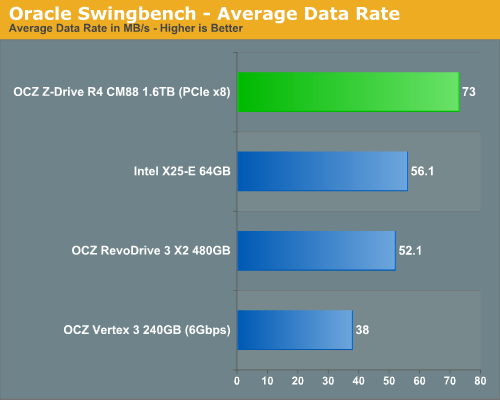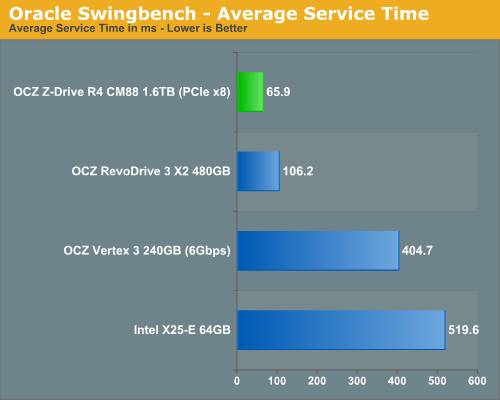OCZ Z-Drive R4 CM88 (1.6TB PCIe SSD) Review
by Anand Lal Shimpi on September 27, 2011 2:02 PM EST- Posted in
- Storage
- SSDs
- OCZ
- Z-Drive R4
- PCIe SSD
Enterprise Storage Bench - Oracle Swingbench
We've been toying with the idea of bringing enterprise performance tests to our SSD reviews for over a year now. We had expected to have more time to launch the suite but the Z-Drive R4 (and another enterprise SSD) were dropped on us unexpectedly so we had to rush things a bit. By no means is this the extent of our enterprise storage bench, but it's a start.
We begin with a popular benchmark from our server reviews: the Oracle Swingbench. This is a pretty typical OLTP workload that focuses on servers with a light to medium workload of 100 - 150 concurrent users. The database size is fairly small at 10GB, however the workload is absolutely brutal.
Swingbench consists of over 1.28 million read IOs and 3.55 million writes. The read/write GB ratio is nearly 1:1 (bigger reads than writes). Parallelism in this workload comes through aggregating IOs as 88% of the operations in this benchmark are 8KB or smaller. This test is actually something we use in our CPU reviews so its queue depth averages only 1.33. We will be following up with a version that features a much higher queue depth in the coming weeks.

Surprisingly enough the SF-2281 based drives don't actually do all that well here. A single Vertex 3 is only good for 38MB/s, while the old X25-E manages 56.1MB/s. The Z-Drive R4 is the fastest drive here but only by 30% margin.

The same results are reflected if we look at disk busy time. However as I mentioned before, this benchmark features a very low average queue depth. With only one IO running most of the time you're not going to see much of a difference between multi-controller and single-controller drives. Despite this fact there's still a 90%+ advantage the Z-Drive R4 enjoys over a single Vertex 3, implying that there are periods of extremely high queue depths that are simply being hidden in the average. In order to see how well the drive does in these periods of very heavy IO activity we need to look at another metric: average service time.

Average data rate and disk busy time tell us how much data is moved but they don't tell us how quickly each stacked IO completes. Average service time gives us this data. Here we see huge performance advantages for the SF-2281 drives, and the Z-Drive R4 is significantly faster than even the RevoDrive 3 X2.
Both metrics are important - one gives you an idea of average performance while the other illustrates how the drive performances under heavy load.










57 Comments
View All Comments
josephjpeters - Tuesday, September 27, 2011 - link
And why is that? Because of the supposed high failure rates? Can you supply any real information about this?OCZ has less then 1% failure rate. There may be more then 1% of customers who have "issues" but they aren't related to the drive. User error plays a pretty big role, but of course it MUST be OCZ's fault right?
Enterprise customers are professionals who know how to install serious hardware like this. And if they don't? OCZ will help install it for them on site. That's what enterprise companies do!
Troff - Tuesday, September 27, 2011 - link
I don't believe that 1% number for a second. First of all, I read some return stats from a store that listed the RETURN rate at just below 3%. Secondly, I know of 5 very different systems with Vertex 3 drives in them. All 5 have recurring lockups/BSODs. The people who built and run these systems write their own filesystems. They are extremely knowledgeable. If they can't make them run properly, they are not fit to run outside of a lab environment.That said, I suspect it's as much Sandforce that's the problem as it is OCZ.
josephjpeters - Wednesday, September 28, 2011 - link
I think it's an Intel problem. But NooOoOo... it can't be an Intel problem...geddarkstorm - Wednesday, September 28, 2011 - link
From all the data I've been seeing, it seems to be a SATA III issue, and an issue with motherboards not being reading for such high volumes of data flow. Mechanical drives can get no where near SSD speeds, and I don't think manufacturers were really expecting how fast they'd go on SATA III (almost pegging it out at times, and it's brand new!).josephjpeters - Wednesday, September 28, 2011 - link
Exactly. It's not an OCZ issue, it's the motherboard. When will someone step in and take the blame?Beenthere - Tuesday, September 27, 2011 - link
SSDs appear to be an on-the-job learning program for SSD manufacturers with all the issues that currently exist.I do not however believe they are selling SSDs at low margins.
Enterprise won't use SSDs yet for the same reason informed consumers won't use them - they have serious reliability and compatibility issues. Unless you can afford lost data and a hosed PC, SSDs are not even an option at this point in time. Maybe in a couple more years they will sort out the problems that should have resolved long agao?
dave1231 - Tuesday, September 27, 2011 - link
I wonder really how much a consumer SSD costs to produce. Saying that slim margins will force companies out of business if there's a big markup on a 128GB is not true. These same drives were $100s of dollars last year and probably still aren't good value today. Unless you're saying consumers are waiting for the .50c/GB drive.josephjpeters - Tuesday, September 27, 2011 - link
It's roughly 20% margins and the price of an SSD is directly related to the cost of Flash. Owning the controller IP is key in maintaining solid margins.Enterprise drives will drive flash demand which will lead to economies of scale that result in cheaper Flash prices and consequently cheaper consumer SSD's.
ChristophWeber - Tuesday, September 27, 2011 - link
Anand wrote: "I've often heard that in the enterprise world SSDs just aren't used unless the data is on a live mechanical disk backup somewhere. Players in the enterprise space just don't seem to have the confidence in SSDs yet."I use an SSD in an enterprise environment, a first gen Sandforce model from OWC. I do trust it with my main workload - database and web server in this case, but of course it is still backed up to mirrored hard drives nightly, just in case.
I'd have no qualms deploying a Z-Drive R4 in one of our HPC clusters, but it'd be an RM88 model with capacitors, and I'd still run the nightly rsync to a large RAID unit. Now if someone would finally signal they want to spend another $100k on a cluster, and I'll spec a nice SSD solution for primary storage.
nytopcat98367 - Tuesday, September 27, 2011 - link
is it bootable? can it b used 4 a desktop too?